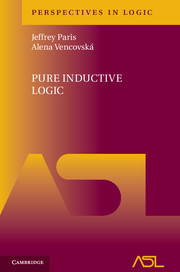Book contents
- Frontmatter
- Contents
- PREFACE
- Part 1 The Basics
- Chapter 1 Introduction to Pure Inductive Logic
- Chapter 2 Context
- Chapter 3 Probability Functions
- Chapter 4 Conditional Probability
- Chapter 5 The Dutch Book Argument
- Chapter 6 Some Basic Principles
- Chapter 7 Specifying Probability Functions
- Part 2 Unary Pure Inductive Logic
- Part 3 Polyadic Pure Inductive Logic
- BIBLIOGRAPHY
- Index
- Symbols and Abbreviations
Chapter 5 - The Dutch Book Argument
from Part 1 - The Basics
Published online by Cambridge University Press: 05 May 2015
- Frontmatter
- Contents
- PREFACE
- Part 1 The Basics
- Chapter 1 Introduction to Pure Inductive Logic
- Chapter 2 Context
- Chapter 3 Probability Functions
- Chapter 4 Conditional Probability
- Chapter 5 The Dutch Book Argument
- Chapter 6 Some Basic Principles
- Chapter 7 Specifying Probability Functions
- Part 2 Unary Pure Inductive Logic
- Part 3 Polyadic Pure Inductive Logic
- BIBLIOGRAPHY
- Index
- Symbols and Abbreviations
Summary
Having derived some of the basic properties of probability functions we will now take a short diversion to give what we consider to be the most compelling argument in this context, namely the Dutch Book argument originating with Ramsey [122] and de Finetti [25], in favour of an agent's ‘degrees of belief’ satisfying (P1–3), and hence being identified with a probability function, albeit subjective probability since it is ostensibly the property of the agent in question. Of course this could really be said to be an aside to the purely mathematical study of PIL and hence dispensable. The advantage of considering this argument however is that by linking belief and subjective probability it better enables us to appreciate and translate into mathematical formalism the many rational principles we shall later encounter.
The idea of the Dutch Book argument is that it identifies ‘belief’ with willingness to bet. So suppose, as in the context of PIL explained above, we have an agent inhabiting some unknown structure M ∈ T L (which one imagines will eventually be revealed to decide the wager) and that θ ∈ SL, 0 ≤ p ≤ 1 and for a stake s > 0 the agent is offered a choice of one of two wagers:
(Bet1p) Win s(1 − p) if M ⊧ θ, lose sp if M ⊭ θ.
(Bet2p) Win sp if M ⊭ θ, lose s (1 − p) if M ⊧ θ.
If the agent would not be happy to accept Bet1p we assume that it is because the agent thinks that the bet is to his/her disadvantage and hence to the advantage of the bookmaker. But in that case Bet2p allows the agent to swap roles with the bookmaker so s/he should now see that bet as being to his/her advantage, and hence acceptable. In summary then, we may suppose that for any 0 ≤ p ≤ 1 at least one of Bet1p and Bet2p is acceptable to the agent. In particular we may assume that Bet10 and Bet21 are acceptable since in both cases the agent has nothing to lose and everything to gain.
- Type
- Chapter
- Information
- Pure Inductive Logic , pp. 25 - 32Publisher: Cambridge University PressPrint publication year: 2015



